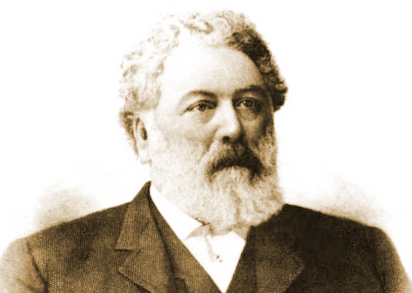
It has been commonly accepted for generations that the little community of Stanwood, Michigan was given its name by Oliver Pillsbury, after he and local lumbermen came across a magnificent stand of white pines. Truth be told, David M. Benjamin, pictured to the left, named the village after his beloved mother, Catharine C. Stanwood.
So, you might be asking yourself, who was David M. Benjamin and what was his importance in the formation and development of Stanwood, Michigan? Well, the following along with this site’s included newspaper articles and portrait biographies will help explain the background of this man and the importance of his association in the formation of the our town.
To summarize, Mr. Benjamin was born and raised in Livermore, Maine. He attended several private schools during his youth, and at 25 he set out to work in the lumber camps along on the Penobscot River.
Mr. Benjamin left Maine when he was 28 for the State of Michigan. It was here that he felt he could capitalize on the State’s booming lumber business. Not too long after settling in Muskegon he met and befriended Oliver Pillsbury and together along with Daniel W. Bradley, they formed the firm of O.P. Pillsbury & Co.
Setting his sights on the abundance of timber north of Grand Rapids, and knowing that the existing logging companies in the area had the Muskegon river too congested, he felt that there was a great opportunity to leverage the railway to move timber. It was also during this time that a group of investors from Fort Wayne, Indiana and Grand Rapids, Michigan wanted to expand their rail system North to Little Traverse Bay. To justify the expense the inventors along with the president of the Grand Rapids & Indiana Railroad needed a financial guarantee that the expansion would prove profitable and David M. Benjamin knew this.
It was in 1868 that O.P. Pillsbury & Co. signed a lease agreement with the Grand Rapids & Indiana Railroad for use of its tracks as the company expanded the system North. The Continental Improvement Company built most of the Grand Rapids & Indiana’s main line. Five different companies and four individuals played important parts in the event, and the interplay between the parties in the undertaking requires a more complete discussion. The companies were the Pennsylvania Railroad; the Pennsylvania Company; the Continental Improvement Company; the Pittsburgh, Fort Wayne & Chicago Railroad; and, of course, the Grand Rapids & Indiana Railroad. The four men most involved were George W. Cass, Thomas A. Scott, William Thaw, and Joseph K. Edgerton.
The State had some steep requirements for the rail expansion project. One of the State’s stipulations required that all rail systems had to connect to a town that by definition had an established Post Office. Working with the Grand Rapids & Indiana Railroad, Mr. Benjamin was able to assist in meeting the State requirements by building several small towns around his company’s key milling facilities, all of which were adjacent to the newly laid tracks. One of the towns became Stanwood.

I think the admin of this web site is genuinely working hard for his website. Quality based information.
Hey There. I found your blog using msn. This is a very well written article. I will make sure to bookmark it and come back to read more of your useful info. Thanks for the post. I’ll definitely return.